PREVIOUS WEEK’S EVENTS (Week 20 – 24.05.2024)
U.S. Economy
Flash Purchasing Managers Index (PMI) figures in the eurozone, the UK and the United States were reported and shook the markets as the figures showed improvements, stronger than expected. An improved performance this month with activity picking up in the United States. U.S. business activity accelerated to the highest level in just over two years in May, suggesting that economic growth picked up halfway through the second quarter.
______________________________________________________________________
Inflation
Canada CPI
Canada’s annual inflation rate slowed to a three-year low of 2.7% in April and core measures continued to ease. Month on month, the consumer price index rose 0.5% in April, also less than a forecast of a 0.6% gain.
The cooling was moderated by gasoline prices; excluding them, annual inflation slowed to 2.5% from 2.8% in March.
Another low inflation report adds to the probability of cuts happening soon.
U.K. CPI
U.K. Inflation eased less than expected and a key core measure of prices barely dropped, boosting expectations for a rate cut soon. The consumer price index (CPI) rose by 2.3% in the 12 months to April, down sharply from March’s 3.2% increase and its lowest since July 2021.
Service inflation was much higher than expected, and petrol prices rose. It inched down to 5.9% from 6.0% in March. Core inflation, which includes goods but not energy, food and tobacco, also reflected persistent price pressures, with the annual rate falling only to 3.9% from 4.2% in March.
Still, expectations for a rate cut from the BoE in June remain high.
______________________________________________________________________
Interest Rates
RBNZ
The RBNZ decided to keep the Official Cash Rate at 5.50%. Its restrictive monetary policy has reduced capacity pressures in the New Zealand economy and lowered consumer price inflation. Annual consumer price inflation is expected to return to within the Committee’s 1 to 3% target range by the end of 2024.
New Zealand’s labour market pressures have cooled. Wage growth and domestic spending are easing to levels more consistent with the inflation target.
______________________________________________________________________
Sources:
https://www.rbnz.govt.nz/monetary-policy/monetary-policy-decisions
https://www.reuters.com/world/uk/uk-inflation-rate-slows-23-april-2024-05-22/
_____________________________________________________________________________________________
Currency Markets Impact – Past Releases (Week 20 – 24.05.2024)
Server Time / Timezone EEST (UTC+02:00)
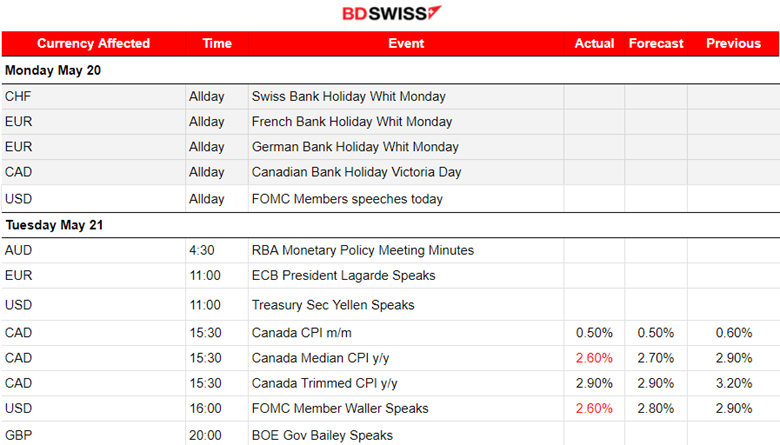
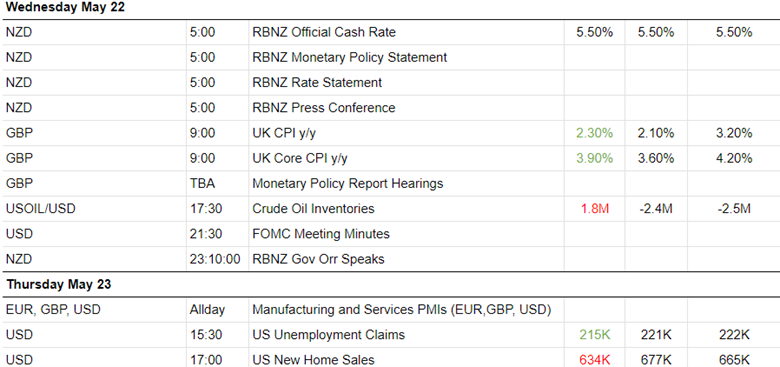
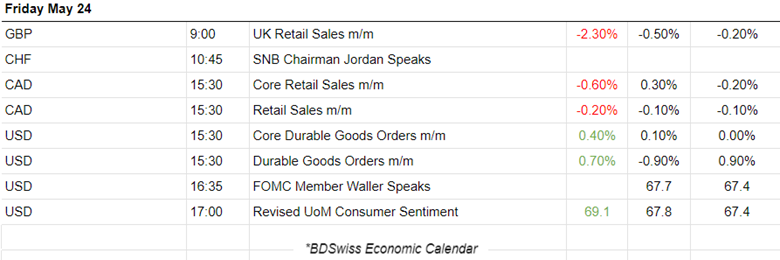
Currency Markets Impact:
The PMI releases were as follows:
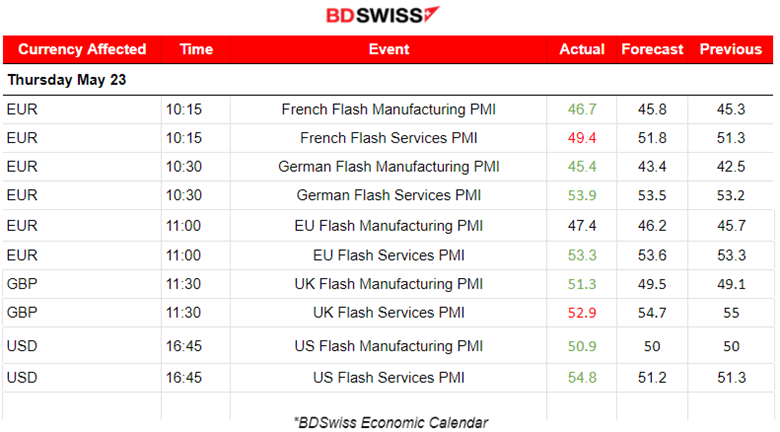
Eurozone PMIs:
In France, the PMI services sector PMI turned to contraction in May after returning to growth at the start of the second quarter.
Germany saw a boost in business activity for the second month and at a faster rate in May. Stronger growth in the service sector with stabilising manufacturing output. Stronger demand and greater optimism towards the outlook. Price pressures meanwhile eased across the eurozone’s largest economy mid-way through the second quarter. Services PMI was reported high at 53.9 points, the highest since June 2023.
In the Eurozone economic recovery gained momentum in May. a. Faster increases in business activity, new orders and employment were all recorded midway through the second quarter. Tates of inflation of both input costs and output prices softened from April but remained above pre-pandemic averages in each case.
U.K. PMIs:
The U.K. PMIs remain in expansion with the services PMI to be reported way worse than expected though. Overall the U.K. registered a solid expansion in May. A resurgence in manufacturing production supplemented a further, albeit slower, upturn in services output.
U.S. PMIs
U.S. business activity growth accelerated sharply to its fastest for just over two years in May—obviously an improved economic performance midway through the second quarter. The service sector led the upturn, reporting the largest output rise for a year, but manufacturing also showed stronger growth.
_____________________________________________________________________________________________
FOREX MARKETS MONITOR
Dollar Index (US_DX)
The U.S. dollar last week climbed overall to high levels and it is quite clear that volatility was really high with several reversals taking place. On the 23rd there was a jump to the upside with 105.16 serving as a strong resistance before a reversal to the downside took place. This U.S. dollar recent appreciation could be a result of expectations towards future appreciation of the currency due to the fact that major central banks are experiencing lower inflation very close to the target level (2%) while the Fed is not. The U.S. does not experience significant inflation cooling, with inflation remaining over 3%, while the labour market data are currently indicating hot signals again. Non-Fed central banks could start interest rate cuts sooner than the Fed. An anticipated high interest rate differential due to different interest rate policies could explain the recent dollar strengthening. The weakening though on the 24th of May is surprisingly high.
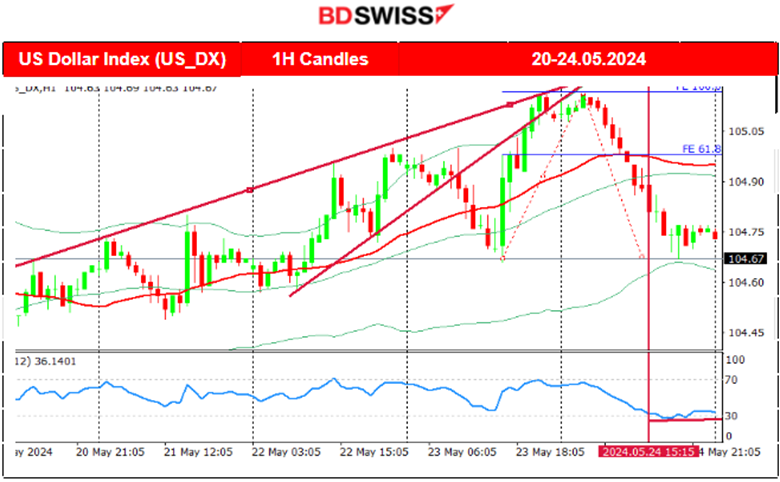
EURUSD
This pair moved to the downside overall and the path is obviously driven by the USD. The EUR is not really affected by the news. The recent data regarding the Eurozone show a turn to improved business conditions, especially in Germany. This keeps the EUR from depreciating significantly. Inflation in the eurozone is lowering as well keeping expectations of cutting interest rates next month steady. The U.S. dollar saw high PMI figures, a rise in durable goods orders and lower unemployment claims, all pointing to U.S> dollar appreciation thus explaining the downward path of EURUSD.
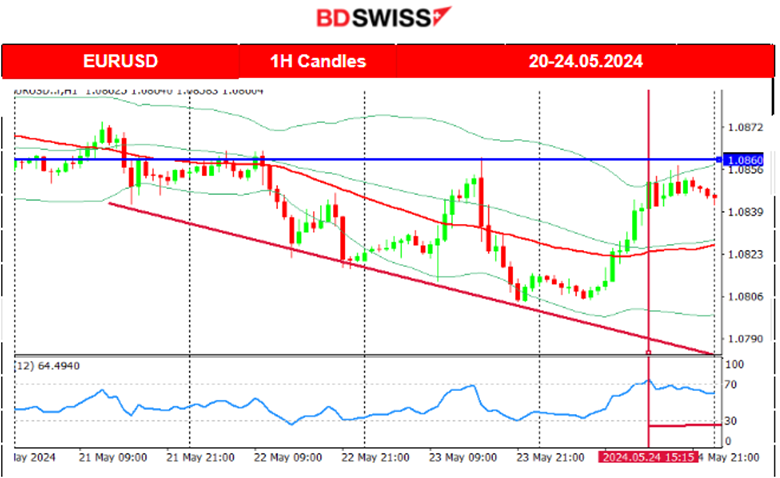
USDJPY
The pair moved steadily to the upside on an upward trend since the 21st of May. On the 24th of May, it found resistance and started a retracement. The USD obviously was the main reason for the overall upward path, but the JPY occasionally experiences high depreciation as well. For example on the 24th, the USDJPY remained high while USD was depreciating against a basket of currencies. The JPY depreciated significantly not only that day but very frequently with most pairs (with JPY as Quote currency) moving upwards (GBPJPY, EURJPY etc.).
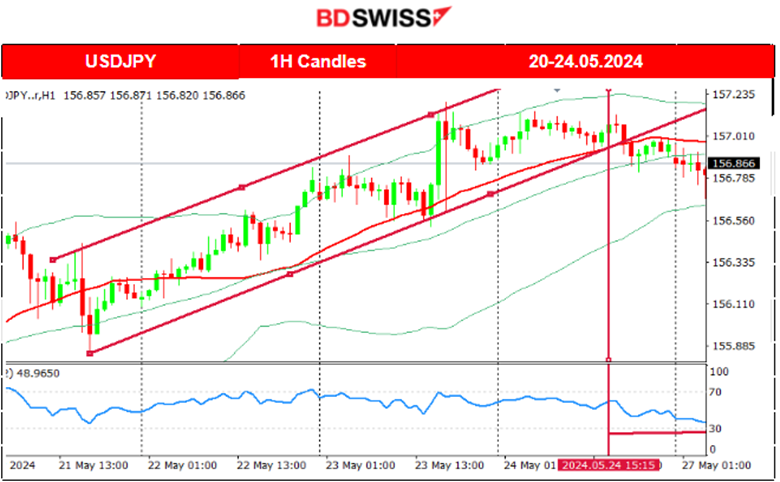 _____________________________________________________________________________________________
_____________________________________________________________________________________________
CRYPTO MARKETS MONITOR
BTCUSD
Bitcoin settled near 70K USD on the 22nd of May. That changed later with Bitcoin moving rapidly to the downside on the 23rd after 16:00. Many assets including stocks and commodities got affected negatively after that time. The price returned back and settled near the 67K USD level wiping out the gains since the jump on the 20th of May.
The price eventually jumped on the 24th of May and continued its upward movement until the resistance at near 69,600 USD. It retraced during the weekend when volatility levels lowered.
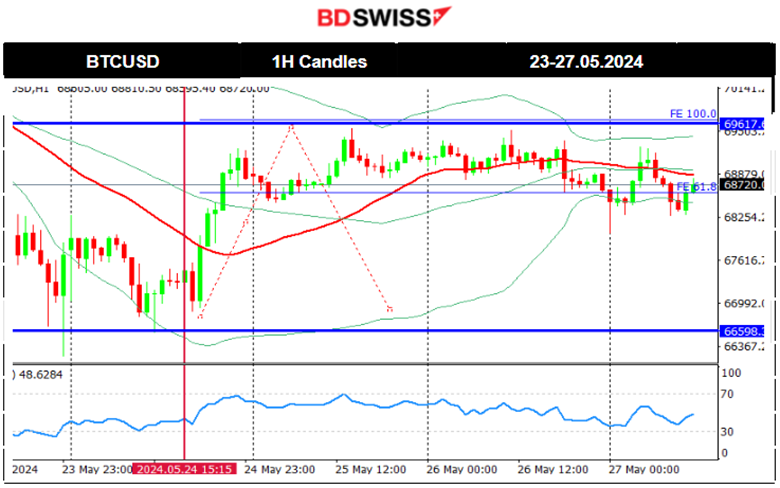 _____________________________________________________________________________________________
_____________________________________________________________________________________________
NEXT WEEK’S EVENTS (Week 20 – 24.05.2024)
Coming up:
Preliminary U.S. GDP figure release for the quarter.
Inflation-related figure releases:
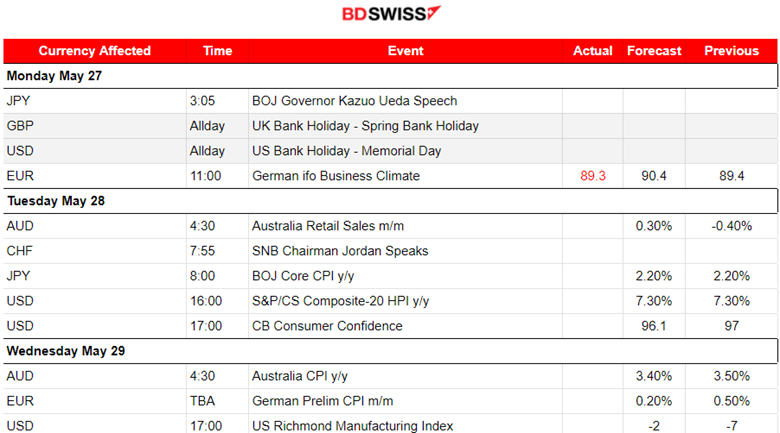
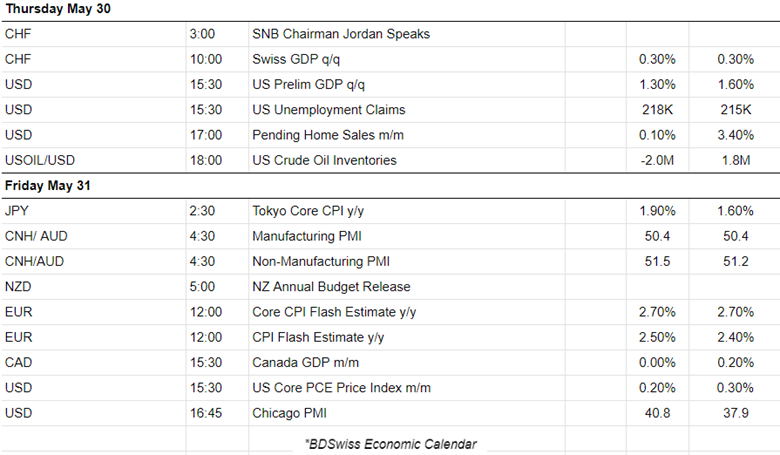
Currency Markets Impact:
After several consecutive months of stronger-than-expected industrial production, a further decline in profits could be a sign of price competition
_____________________________________________________________________________________________
COMMODITIES MARKETS MONITOR
U.S. Crude Oil
On the 21st of May, the price stayed below the 30-period MA and moved even lower today forming lower lows. The bullish divergence was valid as mentioned in our previous analysis. The price eventually jumped on the 23rd of May crossing the 30-period MA on its way up and indicating the possible end of the downtrend. However, that changed when the price experienced a sudden drop after the U.S. PMI release. The momentum was so strong that a new downtrend was created. The price broke an important support near 76.40 USD/b and sparked expectations for a further downward movement to the next support. On the 24th that support was at nearly 76 USD/b. After that, the price reversed to the upside, crossing the MA on its way up and reaching the resistance at near 77.90 USD/b. Retracement has not taken place yet but it could be the case even though the RSI does not show strong bearish signals yet (bearish divergence).
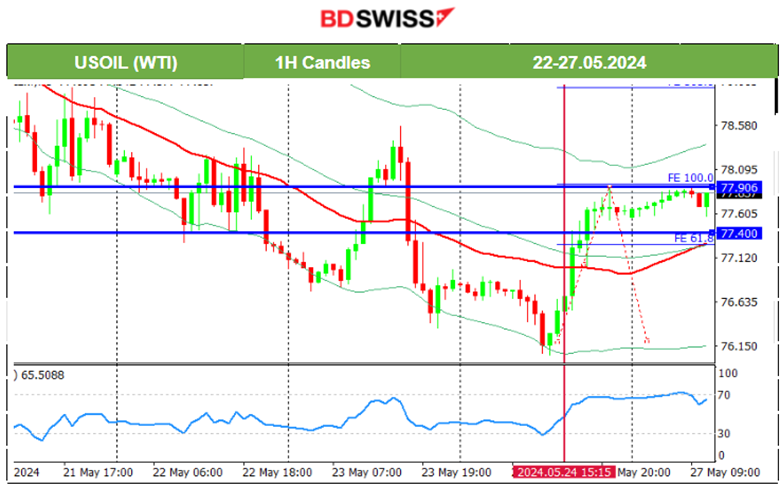 Gold (XAUUSD)
Gold (XAUUSD)
The support on the 22nd of May was broken and the price dropped heavily reaching the support at near 2,355 USD/oz. The downtrend continued until the price reached another important support at near 2,325 USD/oz on the 23rd of May and the potential for a retracement now is apparent with the target level at near 2,360 USD/oz. On the 24th of May, the price has moved only slightly upwards but the potential for a further upward movement still remains.
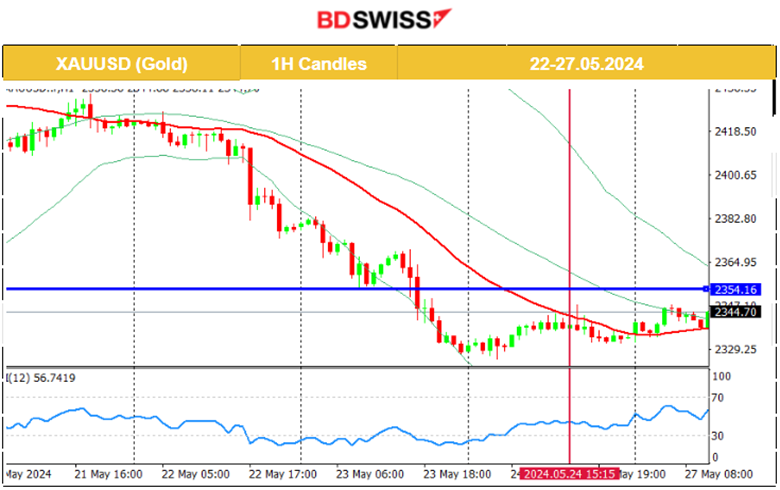 _____________________________________________________________________________________________
_____________________________________________________________________________________________
EQUITY MARKETS MONITOR
S&P500 (SPX500)
Price Movement
The triangle formation that was highlighted in our previous analysis was broken on the 22nd of May and the index moved downwards to the support near 5,290 USD before a full reversal took place. This high volatility depicted on the chart was taking place during the FOMC meeting minutes release. All U.S. indices experienced a pre-market aggressive movement to the upside and broke the resistance at near 5,330 USD reaching only near the peak at near 5,350 USD. Then, after the stock market opening and the release of the U.S. PMI figures all indices dropped heavily on the 23rd of May. S&P500 reached support at near 5,258 USD before a strong retracement took place with an upward steady movement on the 24th of May. The index reached the 5,314 USD resistance that day before it retraced to the 61.8 Fibo level.

______________________________________________________________





